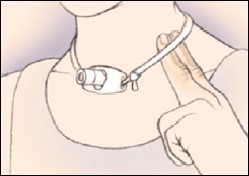Tracheostomy Care
Tracheostomy Care
You need to take care of your trach tube, your stoma, and the skin around the stoma. You will be told by your healthcare team how to do this. The guidelines below may also help you.
Keeping the tracheostomy clean
To take care of your skin and prevent infection, you need to keep your tracheostomy clean. You will be shown how to do this. Clean the tracheostomy at least once a day. Clean more often, if you need to.
Keeping your trach ties clean
Trach ties fit around your neck to hold your tube in place. They will get dirty. Plastic ties can be wiped clean. Fabric ties need to be changed when they are dirty. You will be shown the best way to change your ties.
Keeping the trach tube clear
There is always some mucus in your airway. But mucus can build up and thicken. If this happens, your trach tube can become plugged. To keep the trach tube clear of mucus buildup, you may need to do one or more of the following:
Suction the mucus out of the airway. To do this, you use a special machine. You will be told how to suction and how often.
Moisten the air you breathe. Normally, the nose moistens air as it is breathed in. With a tracheostomy, you need another way to moisten the air, such as using a humidifier. Ask your healthcare provider what method of moistening the air you should use.
You will be told ahead of time what to do if your tube becomes plugged. If you ever have trouble breathing, call 911 right away.
When to call your healthcare provider
Call your healthcare provider right away if you have any of these problems:
Red, painful, or bleeding stoma
Swelling around the trach tube
Fever of 100.4°F (38°C) or higher, or as directed by your healthcare provider
Yellow, smelly, bloody, or thick mucus
Vomiting that doesn’t go away
Coughing up blood
Updated:
September 03, 2017
Sources:
Overview of Tracheostomy. UpToDate., Tracheostony Care: An evidence -based guide to suctioning and dressing changes. Nance-Floyd B. American Nurse Today. 2011;6(7):14-6.
Reviewed By:
Fetterman, Anne, RN, BSN,Mancini, Mary, MD
